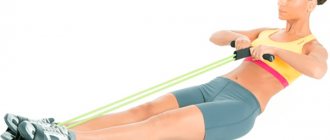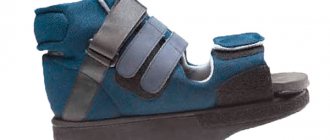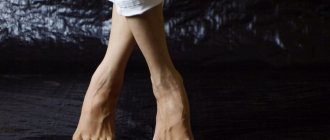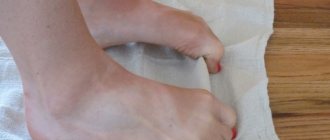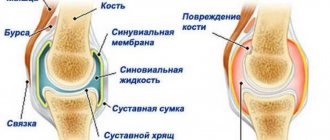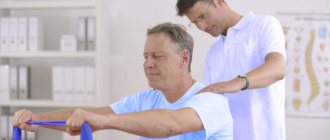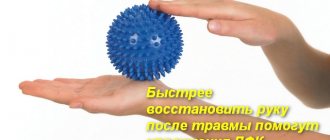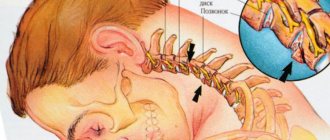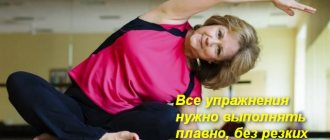Stretching is a very important part of the training process. It is necessary to pay attention to each muscle group, and also do not forget about stretching the Achilles tendon. Since one of the most common closed injuries is damage to the Achilles tendon. Today we have prepared an article for you in which we will present a set of exercises for stretching the Achilles tendon.
Why is stretching necessary?
Often pain in the Achilles area occurs because a person does not do or neglects to warm up before exercise. If the muscles are not warmed up, they will not be able to stretch normally. Then, with a sudden movement, the likelihood of rupture of the heel tendon increases.
To prevent this from happening, you need to perform special gymnastics to stretch the muscles of the calves and Achilles area. However, it is recommended to consult a doctor before exercising. Regular exercise helps stretch the calf muscles and heel ligaments, making them stronger and more resistant to high loads. The main thing is to do the exercises systematically.
Why do feet hurt - causes of foot pain
The causes of foot pain can vary, but the two most common are:
- Plantar fasciitis (inflammation of the area where the fascia connects to the heel bone). Plantar fasciitis often occurs in people with inflammatory arthritis, but it does not always occur. Sometimes the cause of this fasciitis is a shortening of the Achilles tendon at the back of the ankle.
- Achilles tendinitis is inflammation of the Achilles tendon at the back of the ankle as a result of sports injuries, untrained exercise, or arthritis.
In any case, pain in the feet prevents comfortable walking, so let’s look at ways to get rid of such pain, the main ones being medications and exercises for the feet.
Achilles tendon stretching exercises
Before physical activity, it is necessary to develop the Achilles tendon using special exercises:
- Lunges with and without weights. Lunge forward with your right leg, while your left leg is bent behind you. Smoothly lower your torso forward. Then quickly switch legs while jumping. Execution frequency – from 10 to 15 times,
- Exercise on toes with weights. Take the dumbbells in your hands, lower them, stand on your toes and walk for 1 - 3 minutes. Then pause for a few minutes and repeat the exercise again. Make sure that your back is straight and your shoulders are straight while walking on your toes.
The following exercises will help you stretch the Achilles tendon on your leg:
- Sit on the floor , take a towel in your hands, and grab the convex part of your foot with it. Pull your toes towards you, while keeping your legs straight. Hold for 30 seconds. Do 3 times for each leg,
- Sit down and place a cushion-shaped object, such as a can of canned food, under the indentation in your foot. Pump the item back and forth for a few minutes. Do it 2 times a day,
- Sit on a chair , place a towel near your feet. Try to lift the towel with your fingers without lifting your heel. Repetition frequency – from 10 to 20 times. Over time, the exercise can be complicated by attaching some kind of weight to it,
- Starting position too , place your right foot on the knee of your left limb. Grab your fingers and pull them towards you. Maintain this position for about 20 seconds. Frequency of repetitions – 3 times for each leg,
- Stand near the wall , turn to face it, place 2 hands on it at shoulder level, put your right foot in front of your left (the distance between the right foot and the wall should be about 30 cm). Bend the knee of your right limb until tension appears in the calf muscles of your left leg (it should be straight). Repetition frequency: 10 times for each leg. There is only one version of this exercise - the back leg needs to be moved slightly towards the front and bent at the knee,
- Stretch your right hand forward and keep your left hand on your belt. Squat on your heels, trying to maintain balance,
- Stand on the edge of the step platform so that your heels hang down slightly. Rise up on your toes, lifting one leg off the surface. On the count of 5, return to the starting position.
- Stand near the wall at a distance of 70 cm so that you can see it. Then press your heel against the wall and maintain this position for about 60 seconds. Then repeat for the other leg.
All these exercises help to stretch and strengthen the Achilles, then the likelihood of damage is minimal.
Achilles stretching exercises
Exercise 1. Starting position: stand straight, feet hip-width apart, one leg slightly forward. Performing the exercise: Slowly and carefully bend both legs at the knees. The heels should rest firmly on the floor. Repeat the same, placing the other leg slightly forward. This is a basic stretching exercise for the Achilles tendon.
Exercise 2. Starting position: stand on the step so that half of your foot hangs from the step. Performing the exercise: slowly and carefully lower your heels below the level of the step. In this position you need to stay for 20-30 seconds and then return to the starting position. Repeat 3-4 times for each leg. This is a very simple Achilles stretch that you can do every day.
How to strengthen a child's Achilles tendon
to avoid injury to the Achilles tendon in a child, stretch and strengthen it :
- Sit on the floor , stretch your legs, pull your foot towards you. An adult should ensure that the big toe, little toe and heel are in the same plane. Then extend your fingers away from you. Repeat 10 times for each leg,
- Sit down and move your feet in a circle, first inward and then outward 10 times. In this case, you need to try to touch the outer surface of the little finger to the floor,
- Kneel down , sit on your heels, press the bones of your big toe and heel of your foot together. Make sure your child maintains this position for about 60 seconds.
- Sit down, stretch your legs in front of you, pull your feet closer to you. Spread your knees to the sides, press your feet together, lean your hands on the floor, tilt your torso forward, lift your pelvis off the floor, lock in this position,
- Stand on your toes as high as possible, keeping your heels elevated. Then bend your legs and pull your heels forward. After this, lower your heels and straighten your legs. An adult should ensure that the knees and ankles do not turn in or out.
The whole complex takes no more than 10 minutes. The child should perform several exercises per day, and perform the entire complex twice or thrice.
How to stretch the Achilles tendon for a child with cerebral palsy
The Achilles tendon can be stretched and strengthened at any age, regardless of the cause of its injury. There are entire complexes that allow children with cerebral palsy to develop the Achilles tendon:
- Stand with your feet together , then rise and fall on your toes as many times as possible. It is recommended to stand on a step platform or step so that the heel hangs down a little. An adult must secure the child to avoid falling,
- Take a step back, leaning on your front leg, while keeping your back leg straight and on your toes. The heel of the hind limb should be lowered to the floor, while the knee is straightened. If the child simply performs this exercise, then he can take a wider step,
- Sit with your feet in front and reach your toes with your hands. If the child succeeds, then invite him to lift his leg by the toes, supporting the knee with the other hand,
- Lie on your back, lift your leg bent at the knee, press it to your body. Grab your ankle with both hands and pull your foot towards you until you feel tension in the Achilles and calf muscles.
An expanded complex for a child with cerebral palsy will be prepared by a specialist to reduce the likelihood of complications.
How to develop an ankle in the Achilles area after an injury
If the Achilles tendon ruptures, surgery is performed. From the first days after the intervention, the patient should perform special exercises that will improve blood supply to the affected area, prevent the formation of adhesions and help restore mobility.
The complex consists of general strengthening exercises for the arms, shoulders, core and uninjured leg.
The patient moves the fingers of the limb, performs ideomotor exercises (mentally performed exercises), and trains the hip joint. Exercises for the heel tendon depending on the time of injury to the limb:
- From days 3 to 4, static tension of the superficial layer of the lower leg muscles is necessary while attempting to flex the sole of the foot and extend the knee. This exercise should be repeated as often as possible throughout the day,
- 21 days after the operation, a plaster boot is put on the affected leg. At this stage, it is necessary to restore the mobility of the knee and thigh muscles and prevent atrophy of the calf muscles. To do this, the patient performs general strengthening, dynamic exercises with resistance, as well as static exercises for the muscles of the hip joint and lower leg,
- After 6 weeks , the plaster boot is removed, and exercise therapy helps restore range of motion in the ankle, strengthen the muscles of the lower leg and prepare the leg for walking,
- From weeks 6 to 12, the patient begins to perform Achilles stretching exercises. Axial load is allowed, but only with braces (a bar for abduction of the foot) and with crutches. Then you can switch to casual shoes and give up crutches. During this period, it is recommended to place a heel pad in the shoes, the height of which is reduced over time.
An underwater treadmill will help you develop a normal gait and strengthen your muscles. To strengthen the lower leg muscles and restore mobility, a special simulator is used, in which the patient’s foot is fixed, after which he performs exercises. develop and restore the Achilles tendon :
- Flexion of the sole with resistance. The patient’s foot is fixed in a loop of an elastic band and stretched,
- Walking backwards and forwards. The patient turns his back to the control panel, holds on to the handrails and begins to walk with a roll from toes to heel at a speed of 1 - 2 km/h,
- Exercises on a step platform with visual control. The patient climbs onto the platform with the affected leg, while he must look at himself in the mirror,
- Flexion of the foot with the sole and dorsum,
- Running with side steps with resistance. A tape attached to the wall is attached to the patient's waist, after which he performs exercises by running sideways, zigzag, with acceleration, etc.,
- Exercises for training balance while standing on a roller and a swinging platform.
To quickly restore the functionality of the Achilles, it is recommended to carry out a recovery course in a rehabilitation center, where the entire process is supervised by specialists.
Thus, pain in the Achilles tendon area indicates damage, excessive physical activity, inflammation or rupture. To prevent injury or illness, you need to gradually increase the load on your leg and warm up before the main workouts. There are many exercises that will help restore Achilles functionality at any age. The main thing is to perform the exercises strictly according to the doctor’s instructions or under his supervision.
Treatment of Achilles tendon injury
Achilles tendon
- This is the largest tendon in humans. It is formed by the fusion of the posterior muscles of the leg. The presence of the Achilles tendon indicates a distinctive feature of human upright posture. The first mentions of it go back to Ancient Greece, when during bloody wars leg injuries often occurred with damage to the Achilles tendon.
Causes of damage
Quite often, the Achilles tendon can be damaged by a blow to the straightened shin. This injury is not uncommon among athletes, especially football players. Less common in clinical practice are domestic injuries. Injuries from piercing objects in 70% of cases lead to damage to the Achilles tendon along the posterior line.
A degenerative theory is currently being discussed, according to which one of the provoking factors may be the degradation of a special structural protein, collagen, which is part of the tendon tissue. Taking antibiotics from the ciprofloxacin group and corticosteroids increases the risk of trophic changes. Ultimately, the Achilles tendon becomes less strong and can be damaged under the influence of strong mechanical factors.
Symptoms
Signs of Achilles tendon injury vary depending on where the force is applied. If we are talking about a so-called deep rupture, then the pain syndrome may either be absent altogether or manifest slightly. However, the patient is unable to stretch the toe on the injured leg. An hour later, severe swelling occurs, intermuscular and subcutaneous hematomas are formed. If we are talking about a rupture of the Achilles tendon at the site of its attachment, then the defect is visible visually in the form of a tubercle or fossa. A burning, intense pain may be experienced. Movement is also limited.
Three stages of pathology Degree Nature of damage Characteristic features I, II Partial tear
The leg hurts slightly in the damaged area only when walking or exercising. The stretched tendon constantly hurts and swells. Partial loss of motor function of a finger or toe.
III Complete break
Muscle contraction A popping sensation in the sore spot when a rupture occurs Sharp pain and blue discoloration in the affected area
Treatment for the Achilles tendon involves restoring its integrity. The treatment methods themselves can be conservative and surgical (operative). The doctor, based on medical indications and the degree of damage, decides on the method of treatment. The most important thing when choosing treatment is the timeliness and correct diagnosis, because if surgical intervention is required, it must be carried out as soon as possible after the injury, because after a certain time (about 20 days from the moment of rupture), the ends of the Achilles tendon begin to gradually move away against each other, which is facilitated by the shortening of the triceps muscle due to its elasticity and the lowering of the heel tubercle due to loss of function of the triceps surae muscle. It is necessary to understand that treatment of the Achilles tendon may take time depending on the severity of the injury and the individual characteristics of the patient. It is often necessary to resort to intensive drug support, and a set of rehabilitation measures gradually follows from therapy.
First aid
Providing first, emergency aid means that the victim is given painkillers and taken to the hospital. Under no circumstances should you massage the tendon or muscles of the lower leg. It is necessary to apply ice to the damaged area and immediately consult a doctor.
Conservative treatment
At the moment, doctors consider this method of treating Achilles tendon damage to be insufficiently effective for young people leading an active lifestyle and athletes whose goal is to fully recover in order to participate in future competitions.
Conservative treatment consists of stopping the load, resting, applying ice to the joint, applying a splint or splint for immobilization. Recommendations for this treatment are an elevated position of the leg and immobility in the joint for some time. In general, such non-invasive treatment for Achilles tendon damage is effective with strict adherence to all medical prescriptions; often, patients ignore them or follow them incorrectly, which only delays recovery. An important and effective means of treatment is physiotherapy and exercise therapy (exercises and a rehabilitation scheme for rupture of the Achilles tendon are presented in the “Rehabilitation” section). In addition to everything, they also add medicinal support: pain relief, injections, anti-inflammatory drugs, ointments, gels. The use of rational pharmacological agents increases the speed of healing and quickly returns patients to their previous lifestyle. Treatment of Achilles tendon injuries, despite such an extensive list, does not cause inconvenience to the patient, if we take into account selective purchases and discussions with the doctor.
Surgical treatment
For the best treatment result, it is necessary to carry out surgical intervention as soon as possible (if the surgical method is chosen). This is because the soleus and gastrocnemius muscles shorten over time, making it difficult to align the ends of the tendon 18–20 days after injury. That is why treatment of an Achilles tendon rupture must begin promptly, as quickly as possible. Moreover, in the presence of a severe clinical picture of damage, a visit to an ambulance is indicated.
In the classic version of the operation, an incision 8–10 centimeters long is made along the back surface of the leg, access is made to the tendon, its ends are trimmed and stitched with a special strong thread using one of the types of tendon sutures.
Also, the type of surgery is directly related to the type of tear.
In case of open damage, the essence of the operation is as follows:
- without a defect in the tendon or disintegration of its ends, the tendon is sutured end to end with interrupted and U-shaped lavsan sutures, chrome-plated catgut or wire according to the Bunnell method (after six weeks, the wire suture is removed with a special loop through the upper pole of the wound);
- in case of a tendon defect or fiber separation, plastic restoration of the tendon is necessary; bridge autoplasty according to Chernavsky, autoplasty according to Nikitin, lavsanoplasty.
With a closed gap:
- dissection of the skin and various options for end-to-end sutures; plastic restoration using flaps from the proximal and distal ends of the tendon, lavsanoplasty;
- percutaneous submersible suture for fresh ruptures, proposed by S. G. Girshin, professor of the Department of Traumatology, Orthopedics and Military Field Surgery of the Russian State Medical University.
It is important to note once again that complete restoration of the function of the triceps surae muscle in case of rupture of the Achilles tendon is possible only with timely early surgical intervention. If the Achilles tendon rupture is not diagnosed and the patient continues to walk, putting weight on the sore leg, the ends of the Achilles tendon gradually move away from each other, which is facilitated by shortening of the triceps muscle due to its elasticity and lowering of the heel tubercle due to loss of function of the triceps surae muscle. Treatment of Achilles tendon rupture is currently carried out using low-traumatic incisions and modern instrumentation, which does not leave any scars, which are sometimes so frightening for young people. It is important to follow all doctor’s recommendations and a set of rehabilitation procedures.
Self-massage to relax muscles
To prepare the heel tendon for physical activity, and then restore its function and eliminate pain, and relax the Achilles tendon, massage is used. To do this, a person can massage the calf muscle themselves.
During the procedure, it is recommended to use warming ointments, rubbing and some traditional medicine (for example, garlic juice). The following techniques are used to relax muscles:
- “Nippers” are straight, alternately rubbing with 4 fingers, and then with the thumb in a straight line and in a circle,
- Rubbing the calf muscle with the ridges of fingers clenched into a fist in a spiral, rubbing with the pads of the fingers in a circle or straight line. Rubbing movements should be performed along the calcaneal tendon from the heel to the biceps muscle on the back of the lower leg.
The duration of 1 self-massage session is from 6 to 8 minutes.
If muscle “clogging” does not disappear and muscle tone does not decrease, then post-isometric relaxation is performed. These are special exercises that are performed independently or with the help of another person. Standalone option:
- The patient sits and places his foot on his right leg. With his right hand he fixes the heel, and with his left he holds the foot under his toes, trying to bend it towards himself. Achilles stretching time is about 10 seconds,
- Then you need to return the left foot to its original position, while simultaneously overcoming the resistance of the hands. Maintain tension for 10 seconds
- After this, you need to relax your foot, but at the same time, pull the toe towards you with your left hand. Then the heel tendon is stretched again. You need to fixate in this position for 10 – 15 seconds.
So you need to relax and tense the Achilles 3 – 4 times. Then the exercise is repeated for the right leg. With the correct technique, the heel tendon and calf muscles relax.
The option with the help of a partner is more effective, since the degree of muscle relaxation after its implementation is much higher:
- The leg is straightened, the assistant holds it, and then tries to raise the toe as high as possible. You need to fixate in this position for 10 seconds,
- Then you try to straighten your foot, but your partner interferes with your movement. Hold the tension for 10 seconds
- Then you need to completely relax the foot, and the partner again gently pulls the toe to stretch the tendon and muscles of the calf. And then you need to let your leg rest for 10 - 15 seconds.
The cycle is repeated 3–4 times. The main thing is to perform all movements smoothly without sudden movements.
Strengthening the ankle in the Achilles area
Pain that occurs 5 cm from the sole may indicate inflammation of the heel tendon. This suspicion is confirmed if the victim cannot stand on his toes, and when he tries, acute pain occurs. When exposed to negative factors, the likelihood of Achilles tendon rupture increases.
Due to impaired blood supply, the tendon recovers more slowly after mechanical damage or inflammation.
Every day it is subjected to heavy loads, microtraumas appear on it and an inflammatory process develops. To avoid damage to the heel tendon, you need to follow these recommendations:
- Wear the most comfortable shoes, preferably with corrective inserts in shoes,
- Control the frequency, pace, volume of classes,
- Do exercises daily to help strengthen your heel tendon.
To strengthen and pump up the Achilles tendon, you need to squat on your heels every day , perform exercises and stretch the calf muscles. Such training will help improve blood circulation in the Achilles area, metabolic processes, speed up the recovery of the tendon in case of microtraumas and make the muscles stronger.
Symptoms of an Achilles tendon strain
Symptoms of an Achilles tendon strain can occur suddenly (with a massive injury) or develop gradually if the area of damage is small. If you ignore the first insignificant signs, then a clinical picture of the inflammatory process and limited mobility in the ankle joint may develop.
Moreover, with a chronic, neglected process, there is a gradual replacement of tendon fibers with scar connective tissue, which does not have elasticity and the ability to withstand shock-absorbing loads. As a result, the preconditions for Achilles tendon rupture may form.
The first signs of stretching:
- acute pain syndrome with cutting sensations in the area located above the heel;
- increasing swelling of the surrounding tissues around the ankle;
- flexion movements of the foot become difficult when trying to raise the toes towards the shin.
The most common site of sprain is 50mm from the heel bone notch. Among the patients, people aged 25 to 45 years predominate. To exclude bone fractures and cracks in the articular part, radiography is necessary. A sprained Achilles tendon is not visible on x-ray. If necessary, the extent of the injury can be assessed using ultrasound and tomography.
Shortening of the Achilles tendon
Contracture or shortening of the Achilles tendon can occur as a result of intrauterine pathologies of the skeletal structure or due to abnormal gait. Runners who land on the protruding part of the sole rather than on the heel are at risk. Also, the likelihood of a disorder increases with cerebral palsy.
Heel tendon contracture can occur:
- For tendinitis (inflammation of the Achilles tendon),
- Due to sports injuries,
- In case of excessive physical activity with insufficient training or arthritis.
Then pain appears near the heel or in the calf muscles.
The pain intensifies after rest, when the patient suddenly stands up and tries to walk. Also, the heel tendon can shorten due to tendinosis (inflammation and damage to the tissue of the Achilles tendon). This disease is most often diagnosed in patients over 40 years of age and athletes. Doctors distinguish the following forms of tendinosis:
- Peritendinitis is inflammation of the tissues that surround the tendon.
- Enthesopathy is inflammation of the area of the calcaneal tendon where it attaches to the heel,
- Tendinitis occurs as a normal lesion, without damaging nearby tissues.
All these diseases can provoke Achilles tendon contractures. To avoid rupture of ligament tissue, treatment must be started on time.
What Causes a Tendon Strain?
In certain situations and under extreme loads, tendons are often injured - they stretch and can even rupture. This occurs in case of awkward movement, due to wearing uncomfortable shoes, during physical activity or playing sports. In older people, such injuries occur more often due to the decrease in tissue elasticity with age.
When a tendon is stretched, micro-tears of its individual fibers occur. In this case, a few hours after the injury, swelling occurs in the damaged area, a bruise may appear, and pain develops, and the pain intensifies with load on the muscle. If, during an injury, a click or pop is heard, which is accompanied by sharp pain, this indicates that most of the fibers of the tendon are damaged and it is torn.
Despite its strength, the Achilles tendon is often subject to sprains and ruptures. Symptoms of it being stretched: pain and increased sensitivity of the skin in the heel area, the appearance of redness and swelling. This type of injury is characterized by the fact that the pain increases sharply with pressure on the toes or heel. A rupture of the Achilles tendon is accompanied by the sound of a sharp click, sharp pain above the heel, and severe swelling. As a rule, a person cannot stand on the toe of an injured leg1.
Providing first aid in case of injury
The heel tendon can be damaged by inappropriate loads, a direct strong blow to it, or a sharp contraction of the muscles. Most often, such injuries occur in athletes, active people and women who often wear high-heeled shoes.
If the Achilles tendon ruptures, only a doctor can help. The injury manifests itself as sharp pain during training, as from a blow or cut, then swelling appears. If a tendon ruptures, first aid must be provided:
- The victim needs to be laid down
- Elevate the sore leg so that the swelling does not increase,
- Apply a cold compress
- Apply a tight fixing bandage,
- The patient is then transported to the emergency room.
After injury, the patient must avoid physical activity for 2 weeks to 6 months.
Preventive measures
To avoid damage to the Achilles tendons, you must follow these rules:
- Increase the load gradually. It's better to walk a little every day, rather than walking once a week for many hours,
- Buy the right shoes. Wear athletic or casual shoes that provide good support for your feet. If your doctor recommends wearing orthopedic insoles, you should definitely buy them.
- Warm up your feet every day. To do this, stretch or perform circular movements with your feet. If you have a sedentary job, get up every 30 minutes to walk
- Allow your legs to recover from hard training. After grueling sports activities, allow the body to recover; to do this, you can reduce the intensity of the load or give preference to mixed training. It is not worth loading the heel tendon every day, as the risk of their destruction increases,
- Before training, do a dynamic warm-up (lunges with dumbbells, tiptoe exercises), and after it static stretching.
If painful sensations appear at the beginning of exercise, but disappear after warming up, then increase the duration of muscle warming up or pause between exercises. If discomfort appears after training, then reduce the load and keep your feet warm.
Treatment Methods for Achilles Tendon Strain
At the initial stage, treatment of Achilles tendon sprain consists of the following measures:
- immobilization of the ankle joint with the exclusion of any mobility in it;
- cold in the first 36 hours, warm compresses after this time for 72 hours;
- taking non-steroidal anti-inflammatory drugs to reduce pain (ortofen, baralgin, ibuprofen);
- tight bandage and exclusion of physical activity for 2 - 3 months from the moment of injury.
In the future, a course of rehabilitation is necessary to help prevent recurrent injuries and sprains of the Achilles tendon. This will require the selection of comfortable orthopedic shoes, compliance with the rules of distribution of physical activity and special physical therapy. A manual therapy specialist may recommend therapeutic massage, acupressure, and special exercises. All this will help avoid the development of contractures (limited mobility) and the development of connective tissue scars.
